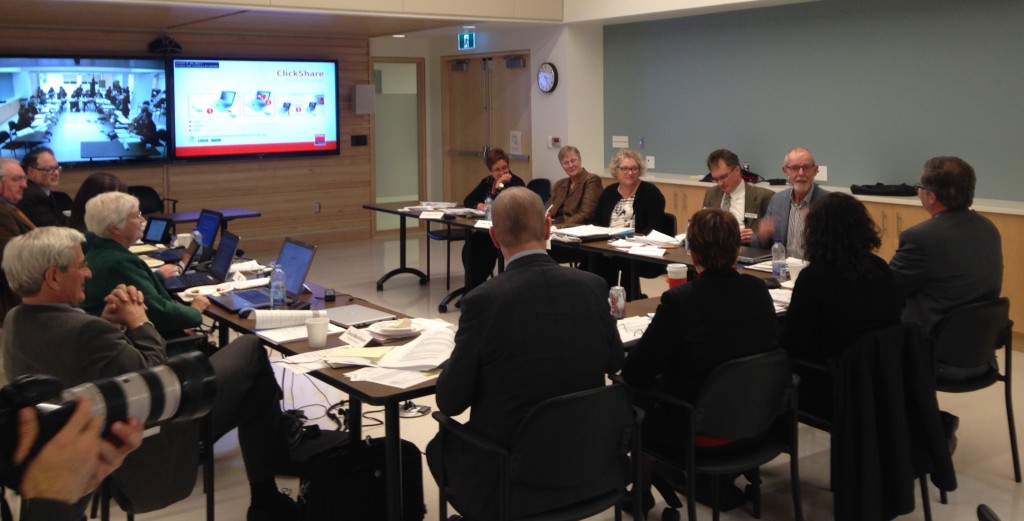 [1]
[1]BELLEVILLE – Members of the board of directors of Quinte Health Care discuss the 2016-17 budget at Tuesday night’s meeting, held in the Education Centre of Belleville General Hospital. Photo by Mark Hodgins, QNet News
By Mark Hodgins [2]
BELLEVILLE – Quinte Health Care [3]‘s board of directors voted unanimously on Tuesday night to move forward with a budget that will see 84 jobs cut at three of the four local hospitals.
QHC will be eliminating 162 positions in total while creating 78, which means a net loss of 84 jobs. While the board has not said which positions will be eliminated and what the new jobs created will be, there have been media reports that 33 of the positions cut will be full-time nurses and 12 will be part-time nurses.
The job cuts will help reduce QHC’s 2016-17 budget by $11.5 million. The board will also cut $4.5 million from patient-care areas and $7 million in administration and support departments.
The staffing changes will hit Belleville General Hospital the hardest, with 117 of the eliminated jobs expected to come from there. Trenton Memorial and Prince Edward County Memorial will also see cuts, while the staff at North Hastings Hospital in Bancroft won’t be affected.
Board members admitted there were many tough decisions to make throughout the budget process, but said they were happy that all four hospitals will remain open and 24/7 emergency room service was saved.
“It’s a very good, a very fulsome plan, and not only addressed what the community asked us to but met our obligation” to save money, board chair Tricia Anderson told her colleagues at the meeting at Belleville General Hospital.
The plan has been in the works for months now and has faced some public pushback, most notably (and loudly [4]) from those both in and supporting the group Our TMH (Trenton Memorial Hospital). That group was assembled many months ago when talk first began about the possibility of cuts coming to the Trenton hospital.
That subject was brought up again Tuesday night, as board member David MacKinnon said he’s “very concerned about the quality of the debate in Trenton on health-care issues in recent months.” He went on to say that QHC is “actually increasing the bed capacity of that hospital, not decreasing it. And to my knowledge that simple fact has not come forward with any vigour in public debate.”
Mary-Claire Egberts, QHC’s chief executive officer, also addressed the uproar in Quinte West, saying that she hopes the board will increase its community engagement in an effort to spread the “positive information” – including a 45-page report from the Brighton/Quinte Health Services Advisory Committee [5] – that the board feels may not have been circulating to date.
There were a number of presentations by both staff and members of the board that examined possible risks that might accompany the proposed changes, along with suggestions on ways to mitigate those risks.
For example, a possible increase in emergency room wait times was deemed to be a medium-level risk. To combat that, suggestions were made to improve access to in-patient beds, and to monitor patients’ experience in the ER.
Security was also mentioned. Kim Stephens-Woods, QHC’s chief nursing executive, said that a reduction in hospital security staff is a possibility, but police support and crisis-intervention training for staff members are among the ways to lessen the blow.
Board chair Anderson said she’s comfortable with the mitigation plans in place for all of the assumed risks, but “we cannot take our eye off the ball, because there isn’t a lot of room to move there.”
Board member Patrick Johnston took a moment before the vote was recorded to applaud the work done by all involved, saying how impressed he was by the depth of the analysis done by staff and also mentioning how influential the public’s input was on the budget.
The night was not without some debate, however. Board member Stuart Wright questioned if the province’s plan to move health care away from hospitals and into the community is going to happen soon enough, to which Egberts responded: “I see that there are bumps along the way and that it’s challenging to get there, but if you keep that vision in mind, then we’re working in the right direction.”
Wright took some exception to that: “My concern is that those bumps, as you put them, are patients with health-care issues that need to be served and attended to. And visions and planned-for changes don’t seem to be occurring at a fast enough level to solve the issues of reduced funding for hospitals.”
The 2016-17 budget must now be looked at from a “human-resources perspective,” according to Anderson. She said the board reserves the right to make some changes to the planned budget depending on the outcome of that assessment.
The final draft of the plan is to be finished by January, while the specified changes – including offers of early-retirement packages and position removal or realignment – could begin to take effect in April.